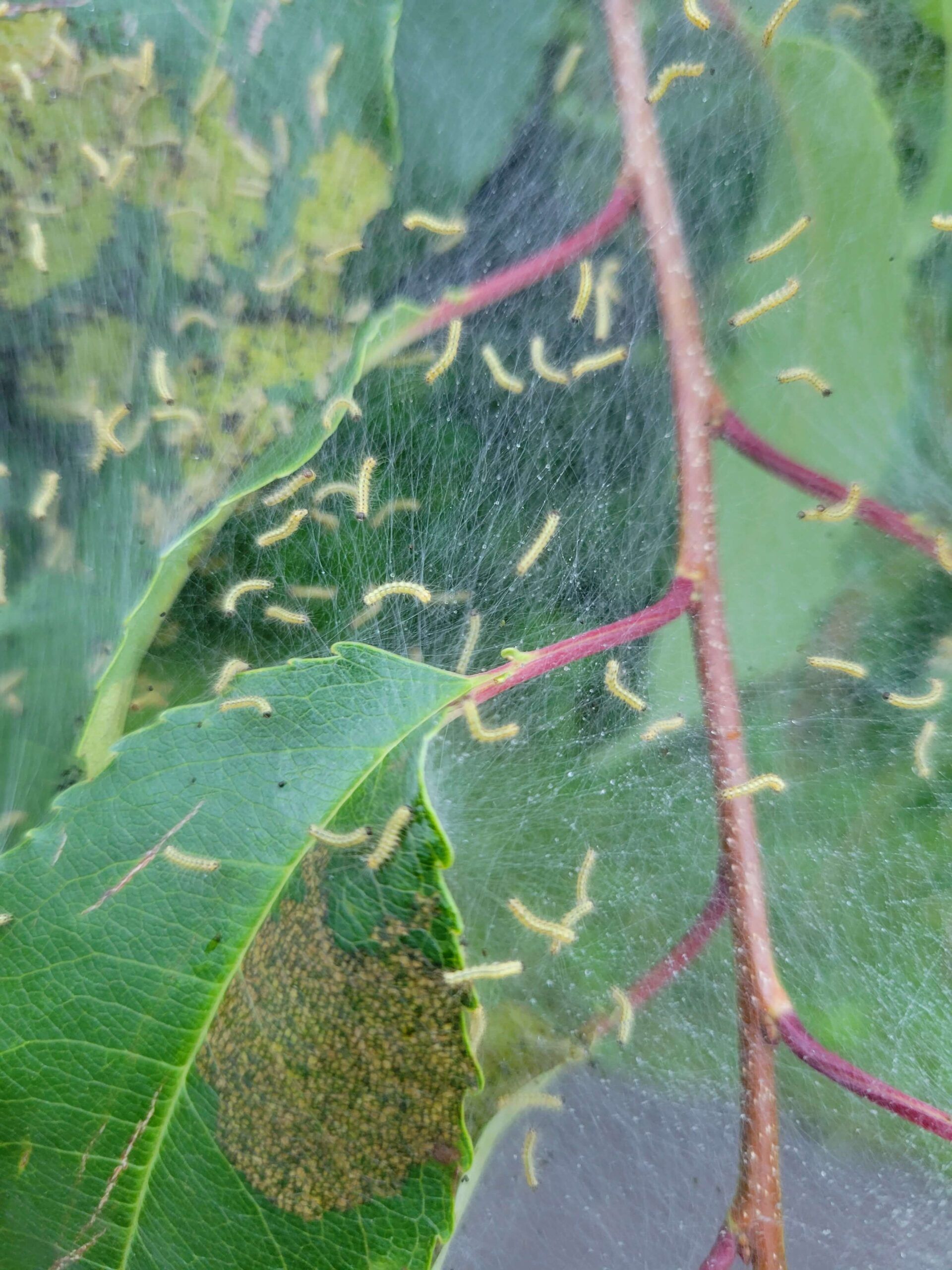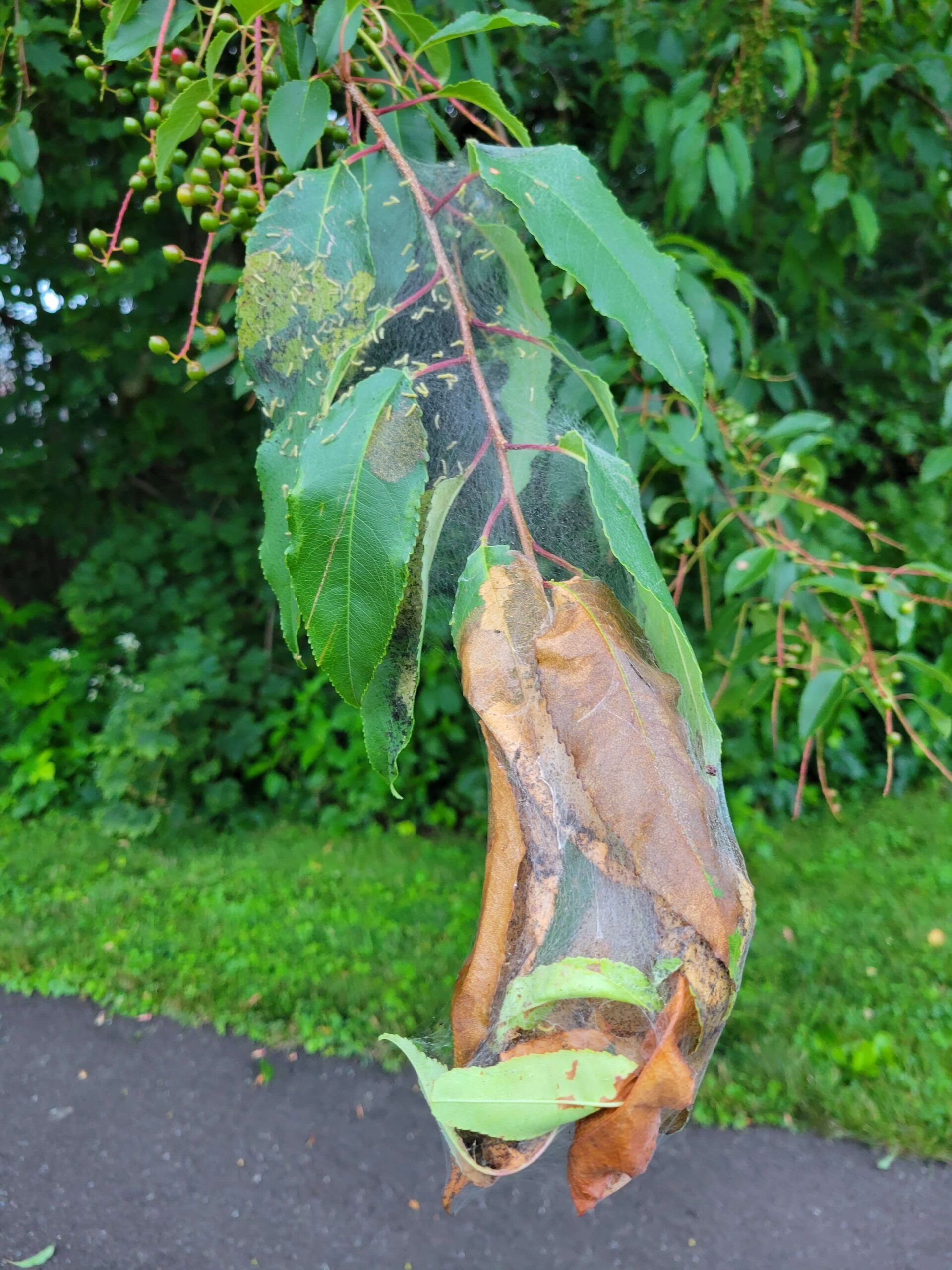Introduction to Fall Webworm
Some insects challenge the health and longevity of our cherished landscape plants and one such pest is the Fall Webworm (Hyphantria cunea). This moth is native to North America and causes significant defoliation and stress to around 90 deciduous tree species, including birch, hickory and walnut. Today we will discuss the physical characteristics, complex life cycle, damage caused by, and management of this insect.
Fall Webworm Appearance
The physical appearance and characteristics of the fall webworm change as it goes through its life cycle.
Egg Masses
The egg masses are tiny and covered in white hairs, giving off an almost cottony appearance. The masses can contain hundreds of these eggs, which are light yellow in color.
Larvae
Upon the initial stages of hatching, the larvae are a pale, almost bleary yellow with two distinct rows of black marks adorning their bodies. As these larvae mature, they display a variation of colors and patterns.
Once full-grown, the larval bodies are covered with fine, whitish hairs originating from distinct black and orange warts.
The coloring of these larvae varies, most often greenish sporting a broad, dusky stripe running along the back and a yellow stripe on their sides.
Pupal and Adult Stages
As the larvae move into pupation, they adopt a brownish color. Adults can vary considerably in their coloration. Some may remain pure white; others appear white with black spots. Adult moths have a wingspread of about 32 mm.
The Lifecycle of the Fall Webworm: A Journey from Pupa to Pest
The lifecycle of a fall webworm begins as a pupa—a hibernating life stage that they assume during winter. During this stage, the pupae envelop themselves in a cocoon while concealed under ground litter, within cracks and crevices of trees, or in the soil.


Emergence and Egg Laying
As winter recedes, adults emerge from their cocoons in early summer, around mid-June. Adults continue to appear intermittently in small numbers through the summer months. Females begin depositing their eggs on the undersurface of leaves.
From Hatchlings to Larvae
The hatching commences approximately seven days after the eggs have been laid. As soon as these larvae hatch, they spin small silken webs or nests over the foliage that is their food source. As they get larger, they expand their area, spinning increasingly large nests to enclose more foliage, and they can eventually grow to a 3-foot span. The remains of these webs can often persist till winter. Larvae sharing their foods and homes with other larvae until their last molt, when they may adopt independent feeding habits.
Maturing
The maturation process of these larvae only takes roughly six weeks. Once mature, these full-grown larvae vacate their webs and pupate in or on the soil—slipping again into dormancy as the temperature decreases.
In our geographic location of Main Line, PA, there’s typically a single generation each year. However, a second generation might occur in certain years and under particular conditions.
Damage Caused by Fall Webworm
During the larval stage, fall webworm consumes leaves inside the protection of their webs, leaving skeletonized leaves. Skeletonization is when only the leaf’s veins, or “skeleton,” remain intact, with the surrounding tissue removed. This prevents photosynthesis and can ultimately lead to the death of a plant.
As the fall webworms grow, they require additional food and will feed on more plants.
While fall webworms may defoliate a tree occasionally and reduce the ornamental value, the pests will rarely kill the tree.
Management of Fall Webworm
Protecting the well-being of your landscape from fall webworms can happen in various ways. Some methods may be better suited to one landscape compared to another. We will explore the management strategies that can help protect your garden from unnecessary harm.
Removing Webs Early
Due to their extensive webbing, the nests tend to be visible on the tree canopy. Whenever you spot a nest, mainly while the nest is still small and easily reachable, a plant health care expert can prune them out and dispose of them. Remember that early detection and removal can help you significantly reduce the size of the webworm population.
Biological Controls
Some biological predators and parasitoids naturally keep specific insect populations in check by feeding on fully-grown pests or even egg masses. Birds, beneficial insects, and certain types of fungi and bacteria all feast on webworms, curtailing their potential to harm your plants.
Insecticides
As a last resort, the careful use of insecticides may be warranted when heavy infestations threaten significant foliage loss. Applying an insecticide, particularly one containing Bacillus thuringiensis or Spinosad, can disrupt the life cycle of fall webworms. Employing these should be a calculated decision because of their non-selective nature, so as a result, a plant health care expert should be involved to ensure any insecticides are applied correctly and their effects on non-infested plants minimized.
Integrated Pest Management (IPM)
Integrated Pest Management (IPM) is a comprehensive and coordinated approach that combines a variety of tactics for long-term management of pests. This approach aims to minimize risks to people and the environment. IPM includes techniques such as biological control, habitat manipulation, modification of cultural practices, and use of resistant varieties.
Contact Burkholder PHC for Pest Management Services
Some species of insects, like fall webworms, have the potential to harm people’s landscapes. Burkholder PHC has years of experience helping homeowners in the Main Line region care for plants and manage insects. Our specialists will survey your property, evaluate your plants, diagnose the issues, and inform you of the recommended treatment options. Contact us today for a free consultation.

